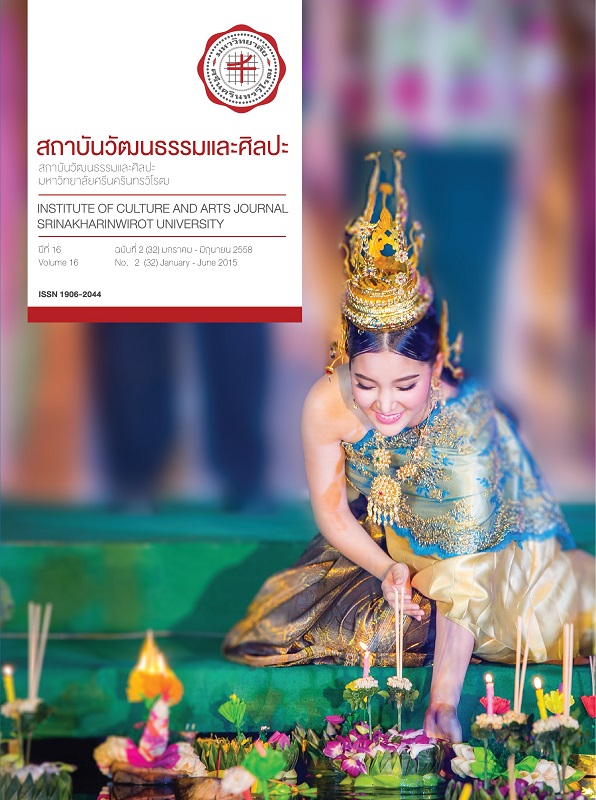การเปรียบเทียบจิตรกรรมของวิถีคนต่างวัฒนธรรม ในเขตเมืองหาดใหญ่ จังหวัดสงขลา A COMPARISON OF PAINTINGS IN THE MULTICULTURAL DIMENSIONS OF HAT YAI CITY, SONGKHLA PROVINCE
บทคัดย่อ
บทคัดย่อ
การศึกษานี้มีจุดประสงค์เปรียบเทียบจิตรกรรมของคนต่างวัฒนธรรม ในเขตเมืองหาดใหญ่ โดยใช้วิธีการสังเกต และสัมภาษณ์เชิงลึกศิลปินแต่ละกลุ่มวัฒนธรรม ได้แก่ 1) วัฒนธรรมไทย 2) วัฒนธรรมจีน 3) วัฒนธรรมมลายู นำมาวิเคราะห์เปรียบเทียบ สรุปเชิงพรรณนาความ
ผลการศึกษาพบว่า ศิลปินแต่ละกลุ่มมีแนวสร้างสรรค์จิตรกรรมแตกต่างกัน ศิลปินในวัฒนธรรมไทยมี หลักคิดศิลปะที่ทำให้ดูง่ายเน้นรูปแบบนามธรรม มีเรื่องราวจากธรรมชาติแต่สลายรูปทรงแฝงปริศนาธรรม ภายใต้บริบทสังคมพุทธแบบเถรวาทในสถานะบรรพชิต ให้คุณค่าสุนทรียะกับการตอบสนองสิ่งเร้าที่บริสุทธิ์และแสดงสัจธรรมธรรมชาติ ศิลปินจีนมีหลักคิดที่การยึดประเพณี เน้นรูปแบบกึ่งนามธรรมแบบจารีต มีเรื่องราวธรรมชาติที่เป็นมงคลผสานคำคม ภายใต้บริบทสังคมแบบมหายาน เต๋า ขงจื้อ ให้คุณค่าสุนทรียะที่การใช้พู่กัน การสะท้อนภูมิปัญญาและจริยธรรม ศิลปินมุสลิมมีหลักคิดที่ศิลปะต้องแสดงความเป็นพื้นบ้าน เน้นรูปแบบกึ่งนามธรรม เรื่องราวธรรมชาติแต่แฝงอัตลักษณ์อิสลาม เช่น พระจันทร์เสี้ยว ภายใต้บริบทสังคมมุสลิมซึ่งปรับตัวกับโลกที่เปลี่ยนแปลง สุนทรียะมีทุกหนแห่ง ทุกคนรังสรรค์ได้เพื่อสะท้อนวัฒนธรรมอันหลากหลาย สิ่งที่ศิลปินทุกกลุ่มมีเหมือนกันคือใช้รูปแบบและเรื่องราวจากการคิดคำนึงผสานจินตนาการ มีทัศนะเชิงสุนทรียะกับการจรรโลงโลกให้ปิติ ทำสิ่งหยาบให้น่าชื่นชม ศิลปะ และความงามมีความหมายต่อชีวิต ช่วยให้มนุษย์จิตใจประณีต สงบ เห็นสัจธรรม เข้าใจวัฒนธรรมคนอื่น และอยู่ร่วมกันได้ กล่าวคือจิตรกรรมเป็นเครื่องแสวงหาแก่นชีวิต ที่ช่วยร้อยรัดวิถีคนต่างวัฒนธรรมให้อยู่ร่วมกันอย่างมีความสุข
คำสำคัญ: การเปรียบเทียบ จิตรกรรม คนต่างวัฒนธรรม เมืองหาดใหญ่
Abstract
This research aimed to compare paintings in the multicultural dimensions of Hat Yai City, using observations and in-depth interviews on artists from different cultures: Thai, Chinese and Malaya culture. The data were analyzed, compared and concluded in a description.
The results showed that each group of artists created paintings with different characteristics. Thai artists based their art on simplification, focusing on abstractness with nature’s inspiration but disintegrated form and embracing the Buddha’s teachings in the Thai Hinayana Buddhist sect of monkhood. They valued aesthetics and responses to pure stimulus and displayed the nature’s truths. Chinese artists, however, strictly observed traditions, emphasizing traditional semi abstract form with nature’s auspicious stories entwining witty speech in the northern school of Buddhism, Taoism, and Confucius contexts. They valued the aesthetics of paintbrush use and the reflection of intelligence and morals. Muslim artists’ concept was that art needed to express its folksiness. They emphasized semi abstract form with nature’s stories and embraced Islamic identities like the crescent moon, in the context of Islamic society adapting to the changing world. Aesthetics is actually everywhere and artists created arts to reflect their multicultural dimensions. What were common among them were the use of form and content from thoughts and imagination, their views that aesthetics can make the world enchanting and rough things delicate. Art and beauty were meaningful to life, making human heart delicate, peaceful, enlightened, perceptive of others’ culture and capable of harmonious living. It can be said that paintings are instruments for the search of life essence that will make lives in the multicultural society intertwine and finally live happily and peacefully.
Key Words: Comparison, Painting, Multicultural dimension, Hat Yai City
Downloads
เผยแพร่แล้ว
How to Cite
ฉบับ
บท
License
บทความทุกบทความที่ได้รับการตีพิมพ์ถือเป็นลิขสิทธิ์ของวารสารสถาบันวัฒนธรรมและศิลปะ มหาวิทยาลัยศรีนครินทรวิโรฒ


